Recently, artificial intelligence has been rumored, especially when robots are blown away, as if they can immediately replace human beings, and even control and manipulate humans in the future, and the last world becomes a robotic world. In fact, such rumors have been moved from science fiction, and can only play the role of sensationalism. Some devices, like the robots in the assembly line, can only work completely in accordance with the prescribed procedures, and can not automatically change with the changes in the environment. As long as the environment changes a little, its work will be wrong, so it cannot be counted. Become a smart device, not to be called a robot. What really matters to us is to use smart technology to solve practical problems from our real work.
The core of intelligent technology is self-adaptation. The technology that automatically adjusts the work of the device to the best results based on changes in the environment is adaptive. With adaptive, you can change the traditional technology to get unexpected results.
Intelligent LED constant current source is an example
1. Classic linear constant current sourceWe know that all power supplies can be divided into two types: constant voltage power supply and constant current power supply. The constant voltage power supply is stable in output voltage and does not change with input voltage and load. The constant current power supply has constant output current and does not follow the input. Changes in voltage and load. Because the LED is a kind of semiconductor diode, its volt-ampere characteristic has a negative temperature coefficient. If it is powered by a constant voltage power supply, it will make its current become larger and burnt, so it must be powered by a constant current power supply. There are also two ways to achieve it, one is a switch type and the other is a linear type. The advantage of the switch type is that the efficiency is relatively high (about 90%). The disadvantages are more components, low reliability, large volume and high cost. The linear constant current source is just the opposite, the number of components is small, the reliability is high, and the volume is very large. Small, low cost, the disadvantage is that the efficiency is very low, only about 85%.
2. The efficiency of a linear constant current sourceThe efficiency of a linear constant current source decreases as the input voltage increases. Its typical efficiency curve is shown in Figure 1:
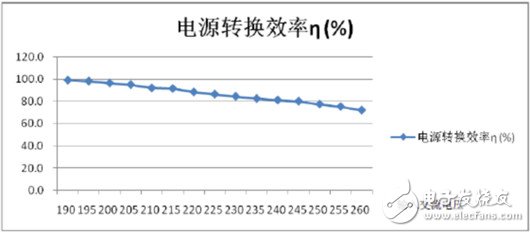
When the mains voltage is 220V, its efficiency is only 85%.
However, the lower the input voltage, the higher the efficiency. Is it possible to make this linear constant current source very efficient at 220V?
This requires us to study in detail the circuit composition and performance of a linear constant current source.
3. Linear constant current source using ordinary constant current diodeThe simplest linear constant current source uses an ordinary constant current diode. Its circuit is shown below:

The CRD in the figure is a constant current diode. Several CRDs are connected in parallel to obtain the required constant current value. In fact, there are many constant current diodes with different constant current values ​​available, so there is no need to use parallel. The way to get the desired constant current value. Therefore, as long as a constant current diode with constant current value and all LEDs are connected in series, the constant current supply to the LED can be realized. It can be seen that the circuit is very simple!
Its working principle can be seen from its volt-ampere characteristics:
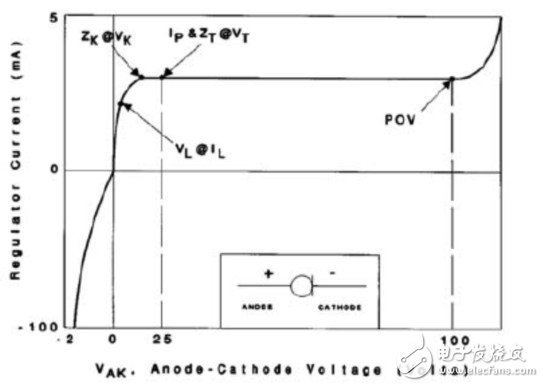
It keeps the current constant from Vk up to the input DC voltage range of the POV. The absolute value of Vk is lower than 3V. Assuming that the rectified DC voltage is 300V and the constant current value is 0.1A, the total power is 30W. If the total voltage of the LED string is just close to 300V, the constant current diode operates at Vk. Point, then it consumes only 0.3W of power, and its efficiency is (30-0.3) / 30 = 99%.
However, when the input voltage increases, the constant current diode must assume the function of consuming these excess voltages, its operating point shifts to the right, and the power consumption increases gradually, and the overall efficiency is gradually reduced, showing its efficiency. The linearity of the drop.
It can be seen that the low-efficiency characteristics of the constant current diode are inherent, and all constant current diodes must be packaged in a package with a large heat sink, which seems unavoidable.
This is what the general textbook says.
4. Using adaptive methods to improve the efficiency of linear constant current sources In order to improve the efficiency of linear constant current sources, we must come up with completely different ways.Because our application is to power LEDs, LEDs are the load of our linear constant current source. The number must be equal to the rectified voltage output. For example, assuming that the rectified voltage is 300V and the forward voltage of each LED is 3V, then 100 LEDs are required to be connected in series. When the mains voltage increases, the rectified voltage also increases, but the LED is powered by the constant current source, so its forward voltage does not change, and the increased rectified voltage must be borne by the constant current diode. The overall efficiency will inevitably decrease.
So is there a way to prevent the constant current diode from increasing the voltage after rectification?
The best solution is to adaptively change the number of LEDs. When the mains voltage rises, the number of LEDs is increased. When the mains voltage is lowered, the number of LEDs is reduced, which can be easily implemented by an adaptive digital switching circuit. Its schematic is shown below.
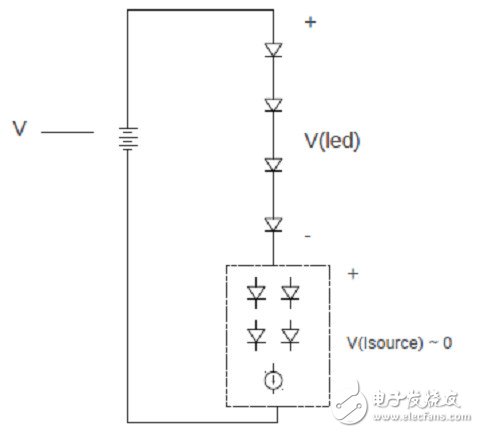
The LEDs in the block can be adaptively connected to the main string LED or can be adaptively disconnected from the main string. The number of accesses or disconnections is determined by the magnitude of the input voltage change. It senses the change in the input voltage and thus determines the change in the number of LEDs, so it is adaptive or intelligent.
Now this kind of chip capable of automatic switching has been successfully developed by Shenzhen Effie, named AICS, which means AdapTIve-Intelligence-Current-Source, which is adaptive-smart-current-source.
5. Performance of intelligent LED constant current source5.1 Adaptive to input voltage
As mentioned earlier, with adaptive control, this constant current source can be as efficient as 99%. Moreover, this efficiency can be achieved over a wide range of input voltage variations. Below is the relationship between efficiency and input voltage variation:
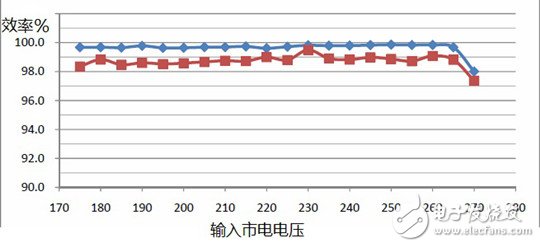
The blue color in the figure is the efficiency of the constant current source itself, and the red is the total efficiency after adding the rectifier. When the mains voltage is changed within 175V-265V, the efficiency of the constant current source can be kept unchanged at 99%, plus the town. The loss of the flow device can also be higher than 98%.
5.2 Adaptive temperature
When the ambient temperature changes, the power consumption of the constant current diode will also increase. For example, when the ambient temperature rises, due to the negative temperature coefficient of the volt-ampere characteristic of the LED, its forward voltage will also decrease. The voltage will be lower than the rectified voltage, so the voltage drop of the constant current diode will increase and the power consumption will increase. This intelligent constant current source increases the number of LEDs in the LED string, causing its total voltage to rise, and the total voltage and the rectified voltage remain matched to maintain high efficiency. The results are as follows:

As can be seen from the figure, when the ambient temperature is raised from 35 degrees to 85 degrees, the overall efficiency is almost exactly the same as the input voltage curve, which is always above 98% (including the efficiency of the rectifier).
5.3 Adaptive of LEDs with different forward voltages
This intelligent LED constant current source also has an adaptive function, which is the adaptation of LEDs with different forward voltages. In the same LED string, LEDs with different forward voltages can be used. After mixing, the adaptive smart LED constant current source can still automatically switch the number of LEDs to ensure that the total efficiency is 99%. This patent has recently been authorized by the US Patent Office.
5.4 change the number of LEDs without changing their luminous flux
If you only change the number of LEDs, the total luminous flux will change because the current of the constant current source does not change. This problem is also considered in the overall design of the intelligent LED constant current source. The current value of the constant current source is also adaptively changed while changing the number of LEDs, so that the total power and the total luminous flux are unchanged. The results are as follows:
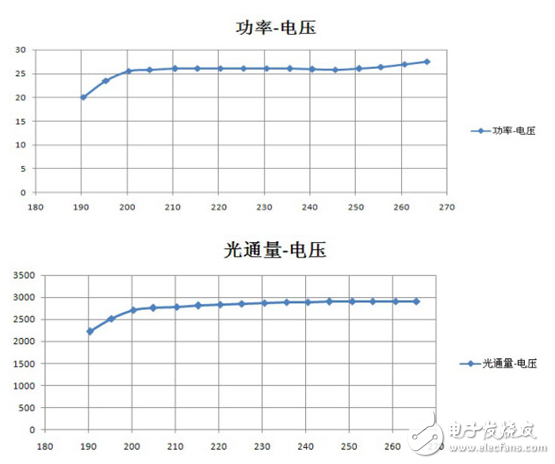
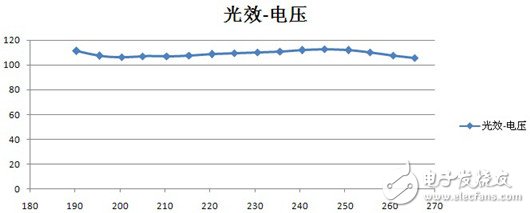
It can be seen from the figure that after this adaptive adjustment, the input power, output luminous flux and overall luminous efficiency remain substantially unchanged over different input voltage ranges.
6. Photoelectric integrated light engineThis intelligent LED constant current source completely breaks the conventional understanding of the linear constant current source described in the textbook, and achieves 99% efficiency. Therefore, the constant current source and the light source can be placed on the same aluminum substrate to form a photoelectric integrated light engine. Because its power consumption is extremely low, placing it on the aluminum substrate of the light source does not increase the junction temperature of the LED. Shenzhen Effie has used this intelligent constant current source to produce a series of light engines of different power:
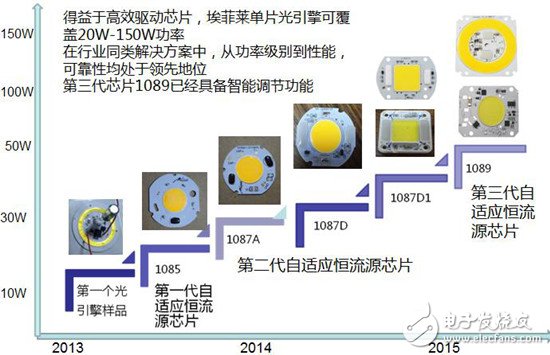
The efficiency of this intelligent LED constant current source is as high as 99%, which is equivalent to achieving a constant current source that does not consume electricity. Usually, the efficiency of the LED constant current source is 85-90%, which means that after using this intelligent constant current source, it can further save energy by 10-15%. Its significance is very significant!
China's lighting power consumption is 14.5% of total electricity consumption. In 2014, the total power generation was 564.96 billion kWh, that is, the electricity consumption for lighting was 819.19 billion kWh. After using Effie's light engine, it can save at least 10% of energy, which is 81.92 billion kWh, and the annual power generation of the Three Gorges Power Station is 84.7 billion kWh, so it can save a Three Gorges power station. The global electricity consumption accounts for 19% of the total electricity consumption. In 2014, the total global power generation was 238.67 billion kWh, so the electricity consumption for lighting was 453 billion kWh. After using Effie's light engine, it can save 453.5 billion. Electricity, equivalent to the power generation of 5.5 Three Gorges Power Station!
Dry Type Special Transformer,Voltage Variable Frequency Transformer,Power Transformers,Moisture Resistance Transformer
SANON DOTRANSÂ Co., Ltd. , https://www.sntctransformer.com